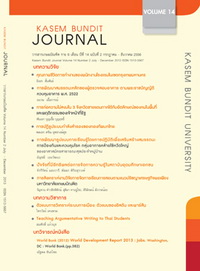การก่อความไม่สงบใน 3 จังหวัดชายแดนภาคใต้กับอัตลักษณ์ของคนในพื้นที่และพฤติกรรมของเจ้าหน้าที่รัฐ
Keywords:
การก่อความไม่สงบใน 3 จังหวัดชายแดนภาคใต้, อัตลักษณ์ของคนในพื้นที่, พฤติกรรมของเจ้าหน้าที่รัฐ, Southern insurgency, Three southern border provinces, Local people identity, Government official behaviorAbstract
การศึกษาเรื่อง การก่อความไม่สงบใน 3 จังหวัดชายแดนภาคใต้กับอัตลักษณ์ของคนในพื้นที่ และพฤติกรรมของเจ้าหน้าที่รัฐ มีวัตถุประสงค์เพื่อศึกษาสาเหตุการก่อความไม่สงบกับอัตลักษณ์ของคนในพื้นที่ และศึกษาปัญหาการก่อความไม่สงบกับพฤติกรรมของเจ้าหน้าที่รัฐ โดยใช้การวิจัยเชิงคุณภาพด้วยการตรวจสอบเอกสารและสัมภาษณ์เชิงลึกกับกลุ่มตัวอย่างที่คัดเลือกโดยวิธีเจาะจง แบ่งเป็น 5 กลุ่ม คือ นักการเมือง ผู้บริหารระดับสูง อดีตผู้ก่อความไม่สงบ นักวิชาการ และผู้นำตามธรรมชาติของคนในพื้นที่ รวมกลุ่มตัวอย่างทั้งสิ้น จำนวน 37 คน
ด้านอัตลักษณ์ของคนในพื้นที่ มีแรงจูงใจจากประวัติความเป็นมาซึ่งขาดการเหลียวแล และไม่ได้รับความยุติธรรมมานานนับศตวรรษ นอกจากนั้นยังมีความแตกต่างด้าน เชื้อชาติ ศาสนา วัฒนธรรม ภาษา และอัตลักษณ์ระหว่างรัฐสยามกับรัฐปัตตานี รวมถึงการดำเนินนโยบายบางอย่างของรัฐที่ขัดต่อวิถีชีวิตของคนในพื้นที่ ด้านพฤติกรรมของเจ้าหน้าที่รัฐ มีสาเหตุจากเจ้าหน้าที่รัฐบางคนใช้อำนาจไปในทางที่ผิด
เพื่อบรรเทาปัญหาการก่อความไม่สงบในจังหวัดภาคใต้ ข้อเสนอแนะทางยุทธศาสตร์ด้านนโยบายดังนี้ ประเภทแรก ที่ใช้แก้ปัญหาต้องเน้นที่การใช้ไม้อ่อนมากกว่าใช้ไม้แข็งประเภทที่สอง เจ้าหน้าที่รัฐต้องพัฒนาระบบการข่าวกรองอย่างมีประสิทธิภาพ ประการที่3 การประชาสัมพันธ์ ต่อกลุ่มเป้าหมาย ต้องยึดแนวพระราชดำรัสของพระบาทสมเด็จพระเจ้าอยู่หัว เรื่อง เข้าใจ เข้าถึง พัฒนา เพราะชาวมุสลิมมีความเชื่อว่าถึงไม่ใช่ญาติก็พี่น้องกัน ประการที่สี่เจ้าหน้าที่รัฐทุกหน่วยงานต้องทำงานไปในทิศทางเดียวกัน มีความเข้าใจซึ่งกันและกัน ใช้แนวทางสันติวิธีและมีความยุติธรรม โดยมีการประเมินผลของคนในพื้นที่ที่เข้ามามีส่วนร่วม เพื่อสร้างความไว้ใจซึ่งกันและกัน ประการสุดท้ายควรใช้ตัวแบบการบริหารจัดการในสภาวะวิกฤตที่ประเทศไทยเคยมีประสบการณ์มาแล้วนำมาประยุกต์เพื่อใช้งานต่อไป
The study on "Southern Insurgency in the Three Border Provinces and Its Local People Identity and Government Official Behavior" aimed to explore the effect of local people identity on the insurgency issue, and the problems from government official behavior in those areas. This qualitative research collected data from documentary sources and in-depth interviews with purposively selected sample comprising 5 groups of 37 people, i e politicians, high-ranking administrators, former insurgents, academics and natural local leaders.
On the issue of the local people identity, the motivation for insurgency had its root from factors of historical background of the three provinces. Main cause of the problem was the government's inadequate attention to local problems. The races, religions, cultures, languages and identities of the peoples in the Siamese and Patani states were also different. The government policies and activities that were not consistent with the islamic religion and way of life of the local people also exacerbate the problems into open conflicts and violence against the government.
In order to alleviate the southern insurgency problem the following policy strategies were recommended. Firstly, the government would rather employ flexible than harsh approach. Secondly, improve efficiency on intelligence system. Thirdly, extend public relation services to the target groups based on His Majesty the King’s direction on “understanding, reaching and developing”. Muslims believe that all are brothers and sisters even though they are not relatives. Fourthly, government agencies should work in the same direction and have mutual understanding of the problems of local people. Government activities in relation to the local people should recognize human rights and justice. Finally crisis management model from the past in Thailand can also be employed in administration.
Downloads
How to Cite
Issue
Section
License
ทัศนคติ ความคิดเห็นใด ๆ ที่ปรากฏในวารสารเกษมบัณฑิตฉบับนี้เป็นของผู้เขียน โดยเฉพาะ มหาวิทยาลัยเกษมบัณฑิตและบรรณาธิการ ไม่จำเป็นต้องมีความเห็นพ้องด้วย







